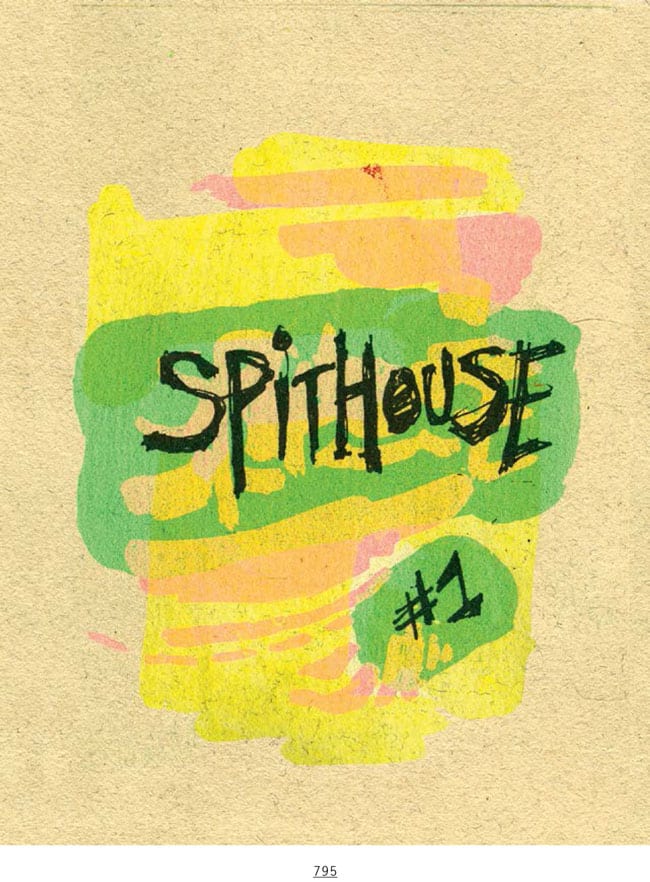In the introduction to the third and final volume of his tribute to the mini-comics art form, editor Michael Dowers traces the wide-ranging scope of the entire collection, which began with Newave!: The Underground Mini Comix of the 1980s and Treasury of Mini Comics Volume One. He follows the form from little-known antecedents in the early half of the twentieth century to the ragged, pre-photocopier obscurities of the late sixties and seventies, on to the boom of the Reagan years and the Generation X era, up to today’s meticulously crafted, colorful art objects, sometimes risographed or featuring fancy silk-screened covers. Volume Two wraps up the trilogy with some quite sophisticated works, such as the full-color minis Spithouse #1 by Leah Wishnia and 5/4 by Nick Bertozzi, both light years from the unassuming work of earlier decades. Minis have come a long way, with their fascinating, previously secret histories still being revealed.
As with the prior installments, Volume Two has its peaks and valleys. Dowers states he wants the series to showcase a wide variety of comics, including “good art, mediocre art, and bad art,” clearly embracing the democratic, all-are-welcome ethos of important '80s-era minis publisher Clay Geerdes (profiled in Newave!). The chronology of featured work is somewhat loose. Rather than following the '80s-themed Newave! with work from the '90s in Volume One and then comics from the '00s and beyond in Volume Two (which I would have preferred, for the sake of clarity), he has opted to include comics of all eras in both Treasury books, which admittedly allows for on-the-spot comparing and contrasting of styles and content from different periods.
Volume Two starts off with “The Hundred Year Old New Waver” from Time Warp #3 by Brad W. Foster, which depicts the old guard mini-comics artist in 2007, bitterly confronting the brand new world of "these punk kids" and the Internet: "Sticking their drawings on a TV screen! That's not publishing, that's just… just… a damn TV show!" Eventually it is revealed (jokingly) that he's living in his mother's basement, irritably correcting her mischaracterization of his creations as "Funny Books": "How many times do I have to tell you? They're Small Press Publications!" It's simultaneously poignant and slyly self-satirizing, drawn in classic big-eyed, cartoony '80s-mini-style. For a more out-and-out rant there’s Jeff Nicholson's Small Press Tirade from 1989, which chronicles the artist's transformation in the small press comic world from young, inspired and ambitious to mordantly cynical, thanks to the often arduous realities of self-publishing. These two comics add a welcome bit of unpretentious, historical flavor to the proceedings, with Colin Upton's A Short Guide to the Care and Production of Mini Comics (1999) contributing a good chunk of old school nuts-and-bolts information for aspiring artists (long live hand-made minis!).
A lot of other ground is covered. Early on, Dowers presents a little tribute to the first minis—namely, "Tijuana Bibles." These were tiny X-rated eight-page comics, published as early as the late 1920s by the Mafia (!), and sold at men's clubs, carnivals, pubs, basically "any place men gathered." A vintage Tijuana Bible, The Van Swaggers (artist unknown) is featured, followed by some fun knock-offs. I especially liked the sexy, light-hearted fun of The Crippler (2007) by Toronto’s Fiona Smyth, featuring a wrestler in a Lucha Libre mask who gets a little “tension release” from his obliging lady friend, and Ethan Persoff and Scott Marshall's pointedly nasty political satire "Obliging Lady", featuring the grotesque mating of George W. Bush and John McCain—clearly a comment on McCain's selling off what was left of his political soul to former sworn enemy Bush in his failed 2008 presidential bid.
The rest of the book cuts a wide swath through the many and varied thickets of small-press ephemera: there's more from notable '80s Newavers like Steve Willis and from artists who emerged during the '90s like Tom Hart, Pat Moriarty, and Johnny Ryan; plus, this being the final book, there's a wide sampling of the work of artists who surfaced in the aughts, like Max Clotfelter, Lisa Hanawalt, Jason T. Miles, Tom Neely, and Souther Salazar. There's superhero parody, cartoony noodling and experimentation, autobio, and monster art. There's also a sampling of non-narrative, art-comics drawings: Sass, a nice 1995 effort from Molly Kiely, is a collection of drawings of famous African American women of song, including Etta James, Nina Simone, and Bessie Smith; Theo Ellsworth's Thought Cloud Shrines (2007) offers a good introduction to this idiosyncratic artist's fabulist universe; the fanciful Shuttle Cakes by Susan Belle (2012) features the titular confections as intricately detailed, celestial objects; and Nine Lives by Kristyna Baczynski, which depicts its cat protagonist’s ability to survive various threats to its mortality (an attacking dog, being sat upon, etc). The rather morbid subject matter is presented with skillful, illustrator-y charm.
Some highlights for me include curios such as Sally Starr, Hollywood Gal Sleuth, a 1972 effort from Trina Robbins. It’s no lost classic, but it is vintage Trina, a rare treat and a reminder once again of the humble mini-comic origins of many famed creators. The Exquisite Corpse Bakes a Pie (1994) is an all-too-brief bit of beautiful grotesquerie from Ellen Forney and Renee French (talk about a dream team!), and Rambo 3.5, by Jim Rugg, is a sharply rendered, vicious satire of George W. Bush, depicted here as a war-mongering imbecile who dreams of a partnership with the infamous fictional Vietnam vet, Rambo. Rugg’s stylistic changes throughout the piece are a tour de force. Acclaimed Canadian artist Marc Bell’s Corn Comics #1, from 1992, is a wonderful piece of free-wheeling silliness (its cast of characters: Chia Man, Monsieur Moustache, Bingo Bango Man, and Mr. Socks), while Allison Cole's Science Fiction Affliction (2004) takes us back to a day in her high school English class, where she is confronted with a nerve-wracking writing assignment while nursing an unrequited crush on classmate Gordon. Cole's uniquely rendered, pod-like characters and deadpan sense of humor elevate what might otherwise have been standard material. Marvels of the Sideshow Freaks by Patrick Dowers (1992) is a nicely stippled series of sideshow portraits, and a good example of the unique and varied minis that Dowers’ Starhead Comics used to issue back in the '90s.
Other notable entries include "Cut Lines and Intricate Minds," from Tel-Tales #1 by master cartoonist Dan Zettwoch (with script by Donald Zettwoch); it’s the first chapter in another of Zettwoch's patented How-Things-Work stories, this time detailing the last remaining toll line in an old Bell Telephone Company building in Louisville, Kentucky that had otherwise switched to radio waves. Zettwoch has a pure and incredibly appealing cartooning style with which he is able to generate genuine reader interest in subjects that would otherwise likely remain pure ephemera.
Esther Pearl Watson (of Unlovable fame) is represented by Eric Parris World, a straight-up adorable bit of whimsy from 2009. Her tall tale begins with the exuberantly fey Eric Parris informing us that a while ago the earth blew up, and the only survivors are fashion models, rock stars, and gangs. The story proceeds naturally (well, sort of) from there. Watson’s distinct, playful pop cultural aesthetic is on full, delightful display throughout.
Caroline Paquita’s Womanimalistic #3 features an enjoyable collection of stylized cartoon drawings from this self-proclaimed “feminist, queer, and total art-freaker.” One of the major disappointments I have with the entire trilogy it is that there are barely any queer artists included. There is a rich field of queer-created minis out there, dating back from at least the early '90s to the present day. Had Dowers featured a sampling of work by even just a few artists, like say Michael Fahy, AK Summers, Diane DiMassa, or any number of others, it would have strengthened the already expansive scope of his series.
In his opening remarks Dowers states that of the three books he feels Newave! is the best, noting that it represents the era in which he was most active and involved in the minis scene—which makes sense. For me Volume One is the best because it focuses more on work by creators like Carrie McNinch, Kelly Froh, John Porcellino, and other like-minded creators of the story-based and auto-bio work that I favor, work which seemingly dominated when I first began reading minis in the early '90s. We all have our own particular coming-of-age eras in comics.
Dowers’ main objective with the trilogy is to give readers “a good overview of what mini comics are about,” with creator interviews scattered throughout offering a glimpse into the reasons they entered the art form and why they continue with it (or not). Mini comics provided the foundation on which many alternative comics creators now stand. They have always been an essential point of entry for countless creators, from the prominent to lesser-knowns. It’s important to remember, however, that not unlike the fact that the short story is a literary form unto itself and not necessarily an entry point for aspiring novelists, mini-comics needn’t be seen as strictly for beginners or only as a springboard for bigger things. It is an ever-evolving art form in itself. Folks like John Porcellino would back me up on this.
Dowers clearly poured a lot of love into this project, but states frankly that it was at times “mind-numbing” and he’s glad it’s finished. He also says he’d love to see how other editors would put together different anthologies of mini comics. I would like to see that myself. These three books, even with their ups and downs, occasional omissions and inevitable flaws, will be a tough act to follow. A tip of the hat to Dowers for successfully navigating a massive, arduous task, and for instigating important archival efforts that will hopefully continue in other, equally capable hands.












